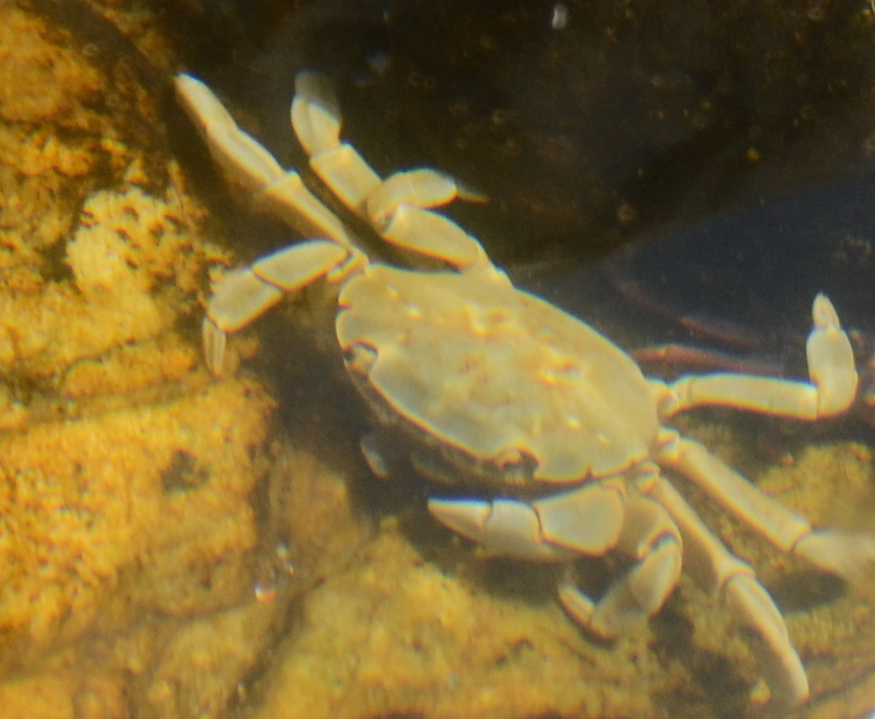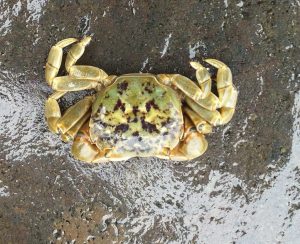
Hemigrapasus oregonensis photo by Anne Stewart. In log
Physical description:
Hemigrapsus oregonensis (Beige shore crab) has dull olive-coloured hairs on its legs and it is lack of reddish spots on the claws. The legs have abundant setae and the chelipeds have no purple spots, but have yellow or white on the tips. There are 3 teeth on the anterolateral margin of the carapace. It has a carapace width ranging up to 34.7mm for males and 29.1 mm for females. It is usually dark or grayish green in color, but white or mottled patterns are common, especially among juveniles. It also has a four-lobed anterior margin.
Global Distribution:
Hemigrapsus oregonensis occurs from the high to low intertidal zones of bays and estuaries from Resurrection Bay (Alaska) to Bahia de Todos Santos (Baja California).
Habitat:
It is most commonly found under rocks, throughout the intertidal zone. They live on open mud flats and in mats of the green alga Enteromorpha and beds of the eelgrass Zostera. It can also be found in rocky habitats within estuaries, gravel shores and in estuaries where it constructs burrows in mud banks. Generally, it prefers more protected and slow water current area. Hemigrapsus nudus always stay together with Hemigrapsus oregonensis.
Feeding:
Hemigrapsus oregonensis feeds mainly at night. The diet of it consists primarily of diatoms, sea lettuce and green algae, but occasionally includes meat if it is available. It scraps up diatoms and crop algae. It also preys on a wide range of small invertebrates, scavenges if it is possible. It can filter-feed by using its third maxillipeds.
Predators:
Predators include shorebirds and Carcinus maenas. A type of red ribbon worm is also a predator of the eggs of Hemigrapsus oregonensis. .
Reproduction:
In northern waters ovigerous females are seen from February to September. The number of eggs carried by the female is ranged from 100 to 11,000 (with an average number of 4,500). Hatching occurs from May to July with one pre-zoeal stage occurring inside the egg. Planktonic larvae develop through five post-hatching zoeal stages. The larvae typically spend five weeks in the plankton.
In August some females produce a second brood which hatches in September. Time from egg deposition to adult recruitment is variable and depends on several factors: the quantity and quality of food available, water temperature and salinity. Altogether it takes about 8-13 weeks for a brood to hatch, metamorphose and be recruiting into the adult population.
Scientific Classification
Domain Eukarya
Kingdom Animalia
Phylum Arthropoda
Class Crustacea
Order Decapoda
Family Grapsidae
Genus Hemigrapsus
Species oregonensis
Common Name: shore crab
Sea otters, currently abundant in Elkhorn Slough and only historically abundant in more northern bays, are limiting Hemigrapsus oregonensis populations. One paradigm in the study of exotic species is that healthy ecosystems, with a full complement of native species, are more difficult to invade than modified systems. In this case, sea otters may be eating the introduced species, as evidenced by Hemigrapsus oregonensis parts in recent scat analyses. While the current West Coast range for Hemigrapsus oregonensis is Morro Bay, California to Barkley Sound, British Columbia, studies at Elkhorn Slough may change how scientists and resource managers predict the impacts of introduced marine species.”
References:(accessed 2005)
http://oregonstate.edu/~yamadas/crab/ch9.htm
http://people.wwc.edu/staff/cowlda/KeyToSpecies/Arthropoda/Crustacea/Malacostraca/Eumalacostraca/Eucarida/Decapoda/
Brachyura/Family_Grapsidae/Hemigrapsus_oregonensis.html
http://oceanlink.island.net/oinfo/intertidal/arthropod.html
http://www.nwmarinelife.com/htmlswimmers/h_oregonensis.html
http://www.ci.edmonds.wa.us/Discovery_Programs%20Website/Crustaceans.html
http://oregonstate.edu/~yamadas/crab/ch5.htm
Marine Invertebrates of the Pacific Northwest by Eugene N. Kozloff
by Student Karyn Wong, PC yr 32 -2005
Other Members of the Phylum Arthropoda at Race Rocks.
and Image File |
 The Race Rocks taxonomy is a collaborative venture originally started with the Biology and Environmental Systems students of Lester Pearson College UWC. It now also has contributions added by Faculty, Staff, Volunteers and Observers on the remote control webcams. The Race Rocks taxonomy is a collaborative venture originally started with the Biology and Environmental Systems students of Lester Pearson College UWC. It now also has contributions added by Faculty, Staff, Volunteers and Observers on the remote control webcams. |

